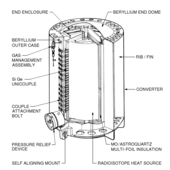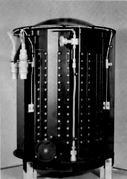A nuclear electric rocket is a type of spacecraft propulsion system where thermal energy from a nuclear reactor is converted to electrical energy, which is used to drive an ion thruster or other electrical spacecraft propulsion technology. The nuclear electric rocket terminology is slightly inconsistent, as technically the "rocket" part of the propulsion system is non-nuclear and could also be driven by solar panels. This is in contrast with a nuclear thermal rocket, which directly uses reactor heat to add energy to a working fluid, which is then expelled out of a rocket nozzle.

Pioneer 10 is a NASA space probe launched in 1972 that completed the first mission to the planet Jupiter. Pioneer 10 became the first of five planetary probes and 11 artificial objects to achieve the escape velocity needed to leave the Solar System. This space exploration project was conducted by the NASA Ames Research Center in California. The space probe was manufactured by TRW Inc.
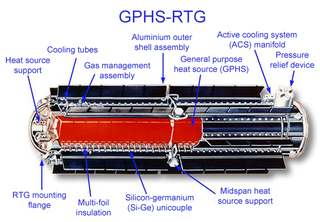
A radioisotope thermoelectric generator, sometimes referred to as a radioisotope power system (RPS), is a type of nuclear battery that uses an array of thermocouples to convert the heat released by the decay of a suitable radioactive material into electricity by the Seebeck effect. This type of generator has no moving parts and is ideal for deployment in remote and harsh environments for extended periods with no risk of parts wearing out or malfunctioning.

Project Prometheus was established in 2003 by NASA to develop nuclear-powered systems for long-duration space missions. This was NASA's first serious foray into nuclear spacecraft propulsion since the cancellation of the SNTP project in 1995. The project was planned to design, develop, and fly multiple deep space missions to the outer planets.
SiGe, or silicon–germanium, is an alloy with any molar ratio of silicon and germanium, i.e. with a molecular formula of the form Si1−xGex. It is commonly used as a semiconductor material in integrated circuits (ICs) for heterojunction bipolar transistors or as a strain-inducing layer for CMOS transistors. IBM introduced the technology into mainstream manufacturing in 1989. This relatively new technology offers opportunities in mixed-signal circuit and analog circuit IC design and manufacture. SiGe is also used as a thermoelectric material for high-temperature applications (>700 K).
A radioisotope rocket or radioisotope thermal rocket is a type of thermal rocket engine that uses the heat generated by the decay of radioactive elements to heat a working fluid, which is then exhausted through a rocket nozzle to produce thrust. They are similar in nature to nuclear thermal rockets such as NERVA, but are considerably simpler and often have no moving parts. Alternatively, radioisotopes may be used in a radioisotope electric rocket, in which energy from nuclear decay is used to generate the electricity used to power an electric propulsion system.

A radioisotope heater unit (RHU) is a small device that provides heat through radioactive decay. They are similar to tiny radioisotope thermoelectric generators (RTG) and normally provide about one watt of heat each, derived from the decay of a few grams of plutonium-238—although other radioactive isotopes could be used. The heat produced by these RHUs is given off continuously for several decades and, theoretically, for up to a century or more.
An atomic battery, nuclear battery, radioisotope battery or radioisotope generator uses energy from the decay of a radioactive isotope to generate electricity. Like a nuclear reactor, it generates electricity from nuclear energy, but it differs by not using a chain reaction. Although commonly called batteries, atomic batteries are technically not electrochemical and cannot be charged or recharged. Although they are very costly, they have extremely long lives and high energy density, so they are typically used as power sources for equipment that must operate unattended for long periods, such as spacecraft, pacemakers, underwater systems, and automated scientific stations in remote parts of the world.
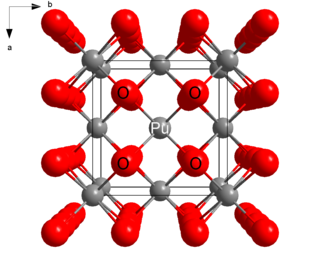
Plutonium(IV) oxide, or plutonia, is a chemical compound with the formula PuO2. This high melting-point solid is a principal compound of plutonium. It can vary in color from yellow to olive green, depending on the particle size, temperature and method of production.
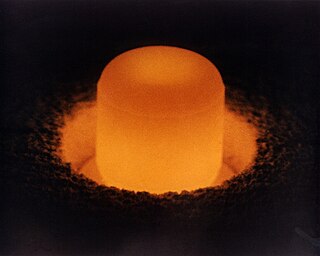
Plutonium-238 is a radioactive isotope of plutonium that has a half-life of 87.7 years.

A Stirling radioisotope generator (SRG) is a type of radioisotope generator based on a Stirling engine powered by a large radioisotope heater unit. The hot end of the Stirling converter reaches high temperature and heated helium drives the piston, with heat being rejected at the cold end of the engine. A generator or alternator converts the motion into electricity. Given the very constrained supply of plutonium, the Stirling converter is notable for producing about four times as much electric power from the plutonium fuel as compared to a radioisotope thermoelectric generator (RTG).
The Systems Nuclear Auxiliary POWER (SNAP) program was a program of experimental radioisotope thermoelectric generators (RTGs) and space nuclear reactors flown during the 1960s by NASA.

The advanced Stirling radioisotope generator (ASRG) is a radioisotope power system first developed at NASA's Glenn Research Center. It uses a Stirling power conversion technology to convert radioactive-decay heat into electricity for use on spacecraft. The energy conversion process used by an ASRG is significantly more efficient than previous radioisotope systems, using one quarter of the plutonium-238 to produce the same amount of power.
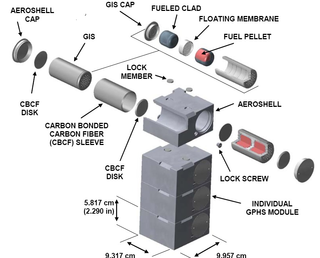
The general-purpose heat source is a U.S. DOE-designed radioactive heat source for radioisotope thermoelectric generators (RTG) or Stirling radioisotope generators (SRG). It is meant for space applications and is packaged as a stackable module.

GPHS-RTG or general-purpose heat source — radioisotope thermoelectric generator, is a specific design of the radioisotope thermoelectric generator (RTG) used on US space missions. The GPHS-RTG was used on Ulysses (1), Galileo (2), Cassini-Huygens (3), and New Horizons (1).

The multi-mission radioisotope thermoelectric generator (MMRTG) is a type of radioisotope thermoelectric generator (RTG) developed for NASA space missions such as the Mars Science Laboratory (MSL), under the jurisdiction of the United States Department of Energy's Office of Space and Defense Power Systems within the Office of Nuclear Energy. The MMRTG was developed by an industry team of Aerojet Rocketdyne and Teledyne Energy Systems.

Nuclear power in space is the use of nuclear power in outer space, typically either small fission systems or radioactive decay for electricity or heat. Another use is for scientific observation, as in a Mössbauer spectrometer. The most common type is a radioisotope thermoelectric generator, which has been used on many space probes and on crewed lunar missions. Small fission reactors for Earth observation satellites, such as the TOPAZ nuclear reactor, have also been flown. A radioisotope heater unit is powered by radioactive decay and can keep components from becoming too cold to function, potentially over a span of decades.
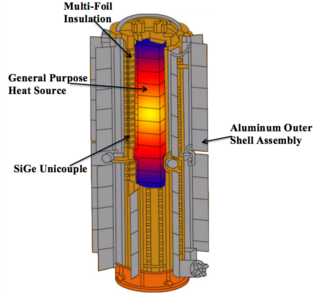
Silicon-germanium (SiGe) thermoelectrics have been used for converting heat into electrical power in spacecraft designed for deep-space NASA missions since 1976. This material is used in the radioisotope thermoelectric generators (RTGs) that power Voyager 1, Voyager 2, Galileo, Ulysses, Cassini, and New Horizons spacecraft. SiGe thermoelectric material converts enough radiated heat into electrical power to fully meet the power demands of each spacecraft. The properties of the material and the remaining components of the RTG contribute towards the efficiency of this thermoelectric conversion.

Galileo was an American robotic space probe that studied the planet Jupiter and its moons, as well as the asteroids Gaspra and Ida. Named after the Italian astronomer Galileo Galilei, it consisted of an orbiter and an entry probe. It was delivered into Earth orbit on October 18, 1989, by Space ShuttleAtlantis, during STS-34. Galileo arrived at Jupiter on December 7, 1995, after gravitational assist flybys of Venus and Earth, and became the first spacecraft to orbit an outer planet.


